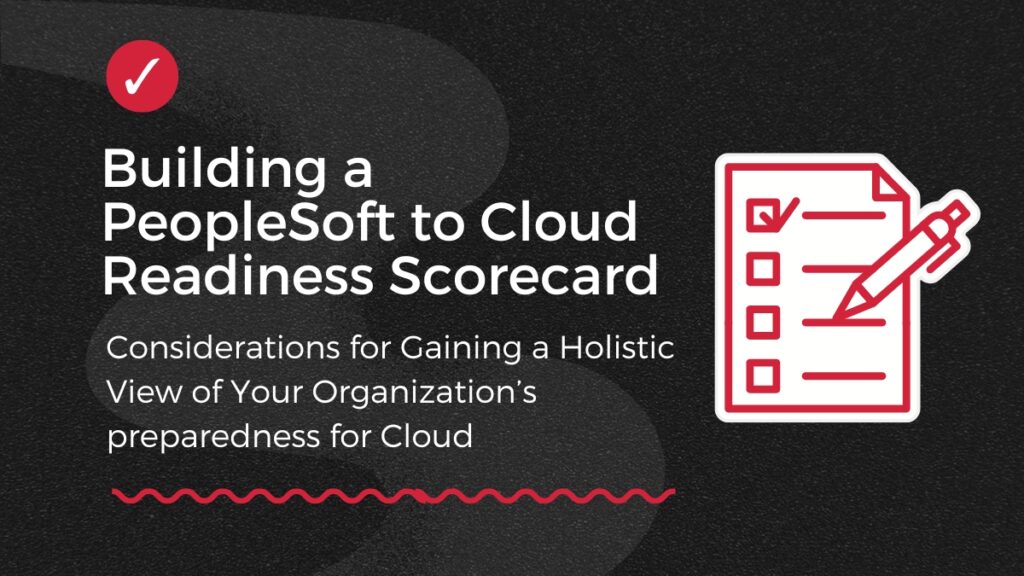
Considerations for Gaining a Holistic View of Your Organization’s preparedness for Cloud
When beginning the journey to the cloud, assessing your organization’s current process, people, and system maturity will give you a head start on determining how ready your organization is to make the move to cloud. Gathering a holistic view including the People, Processes, and Systems requirements -for cloud readiness will illuminate iterative improvements that can be made to better prepare, as well as build a critical roadmap towards cloud migration.
In this blog, we’ll explore 11 criteria Elire uses to determine how ready potential clients are to make the move to cloud. These criteria help determine an organization’s overall “readiness maturity.” The more mature an organization is, the easier the move to the cloud will be. Analyzing and making improvements in these key areas will help strategize for common roadblocks and pain points typical of on-premise to cloud transformations, and build plans to mitigate or avoid them for a smoother cloud transition. (Elire Cloud Readiness Scorecard 11 criteria)
PEOPLE READINESS
1. Motivation
Diving into the key motivations your organization has for moving to the Cloud is the focus when we begin to evaluate this first set of criteria. Building consensus around Clarity of Business Objectives, Alignment of Guiding Principles, Key Stakeholder Buy-in, and adequate Performance Metrics are four factors that go into scoring and evaluating the level of motivation behind your organizations move to cloud. The main reason for this step is simply the fact that for a cloud transformation, if your resources are not aligned on expectations and how to measure success, the project is set to fail from the get go.
2. Governance
Governance readiness is focused on establishing decision-making structures by having a clear governance framework. This includes pre-defined roles, responsibilities, and decision-making processes to guide and oversee the Oracle Cloud migration. Stakeholder engagement is another key pillar of determining governance readiness. Has the organization identified and engaged key stakeholders, ensuring their involvement in the decision? Having key stakeholders on board early on, and identifying proper governance should issues arise helps ensure a project will be successful.
3. Change Management
Change Management evaluates how your organization is going to communicate all of the updates that stakeholders and key business users need on an ongoing basis. What does training look like? Who will be responsible for administering training and what kind of approach will the organization be taking to ensure that training and change management are adequately accounted for? Though often overlooked, training and change management are truly the lifeblood of any project or software implementation. For more on training and change management, read the KPIs for Change Management blog post here. Elire believes that the key to change management is integrating change milestones throughout the project, so users are seeing and gaining confidence in the system throughout the project. This also avoids any issues with “the system is ready, but the people are not.”
4. Resource Strategy
As part of an organizations’ Cloud Readiness, Elire evaluates if key roles have been identified and what the resource allocation plan is. The extent to which the organization has identified and filled the key roles required for a successful migration indicates their level of readiness. Showing their preparedness in terms of resources and skills available is critical. As for resource allocation, having an effective resource allocation plan ahead of a migration to Cloud demonstrates the organization’s ability to allocate and manage resources efficiently during the migration process. A key component to resource allocation is having a plan to support the current application (for some that means Managed Services) during transformation so key resources can upskill to the new application.
PROCESS READINESS
5. Deployment Strategy
Deployment strategy readiness involves tailoring an organization’s migration approach for maximum impact and effectiveness for an organization. This typically means determining whether to move to the cloud with a phased approach, keeping some modules on-prem while moving others to the cloud first, or going with a “big bang” deployment strategy that moves a a key application (HCM, Fin, EPM) from being fully on-prem to fully in the cloud with one go-live date. Also included in Deployment Strategy is determining the project timeline and milestones. Setting these milestones and timeline early allows for foresight of any external deadlines or factors the project implementation team should be aware of.
6. Business Process Transformation
The sixth factor that Elire evaluates is the Business Process Transformation criteria. This element involves identifying and addressing critical gaps in process or functionality so that an organization undergoes a seamless migration. Does the organization understand how their business processes work today, as well as how they will work in the future? Are there any knowledge gaps in how business processes function that will need to be addressed? If so, creating an action plan and integrating any business process change or delivered functionality workshops ahead of beginning the project scope will be necessary.
SYSTEMS READINESS
7. Technical Architecture
Technical Architecture refers to optimizing integrations and extensions for a robust Cloud ecosystem. Determining whether an organization has their current architecture mapped, diagrammed, communicated, and understood as it sits today, as well as what that architecture will look like in the future state after implementing a cloud application is a necessary step ahead of a cloud transformation.
8. Data Conversion Readiness
Particular focus should be on the data structure of today vs. the data structure of tomorrow in a new cloud application. Clients can sometimes overestimate the quality of their data in their current-state, meaning they are inadvertently underestimating the amount of work it takes to migrate their data. Predetermining what data to migrate, what data can be archived, and what tools and templates are needed for data conversion will save time and effort.
9. Reporting Readiness
One of the great benefits of making the migration to Cloud is that there are many improved tools to transform a company’s data into actionable insights. When it comes to reporting, ensuring there is a current-state reporting inventory is critical. Having a list of all the reports the organization uses, what data is on the reports, how the reports are created, how they are distributed, and who is using them, is a transformational step in the planning phase. This will allow the project team to properly scope the number and detail of reports that need to be created in the new system, and allows an opportunity to do some report rationalization to determine reporting needs.
10. Security
Security considerations are key in ensuring compliance and fortifying cloud security. Think about data access, permissions, how these security factors function today, as well as how they will function in the Cloud. Determining key criteria around your security architecture and whether custom or delivered roles will work will help scope out your security planning.
11. Customizations
One of the most cumbersome pieces of a cloud migration is the attempt most organizations make to “lift and shift” current functionality into their new cloud environment. Part of the benefit of Cloud is that you are leveraging best-in-breed practices and technology to support your business and reduce maintainence on the new application. Taking the appropriate time to evaluate customizations will ensure your organization ismaximizing alignment to the new application and minimizing customization complexity.
Asking questions such as “does the organization have an understanding of all their customizations in the current on-prem software? Do we have an inventory of those customizations and how they work? Is there a strategy for dealing with customizations? Are they going to be eliminated or is the cost-benefit to keeping them such that the organization is willing to keep them?” will help qualify your existing customizations and determine scope and priority for pulling the necessary ones forward. Customizations have the potential to derail a project quickly, adding time and effort if customizations are not pre-identified.
How to get started with your Cloud Readiness Scorecard
The Elire Cloud Readiness Scorecard will evaluate your organization’s current application and personnel strengths and opportunities to refine your strategies ahead of cloud migration, saving you time, money, and frustration in the process.
To learn more about Cloud Readiness, view this mini demo presented by Elire’s Head of Delivery Services, Richard Merrill. In the recording, Richard goes into detail regarding the key criteria outlined in this blog that are essential to preparing for Cloud transformation.
Interested in seeing how ready your organization is for Cloud? Schedule your Cloud Readiness Scorecard meeting today and see how your organization is doing. Elire’s team of PeopleSoft to Cloud experts are here to guide you through your implementation. Whether you move in six months or six years – you need a plan to prepare your organization for your future move to the Cloud.
Our team will sit down with your key stakeholders and a set of detailed questions across our 11 key categories to gauge your People, Process, and System maturity at a high level for analysis.
Authors
-

Mr. Merrill serve’s as Elire’s Management Advisory Services Center of Excellence Lead and Head of Service Delivery. Richard’s 20+ Years of Advisory Services and Project Management expertise have developed Elire’s Success Delivered Methodologies and templates to deliver proven, best practice tools for project success.
View all posts -

Ms. Caron serves as Elire's Marketing Manager, specializing in content strategy and digital media communications. Maddie works to deliver relevant industry updates and technical blog posts to educate and engage Elire's audience.
View all posts
